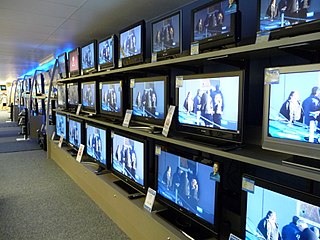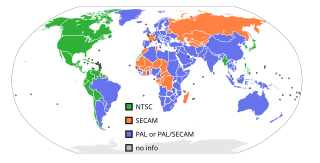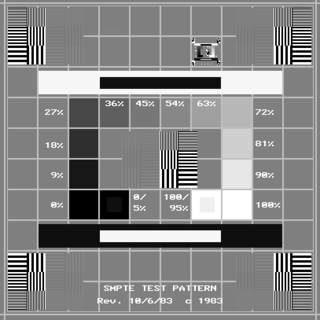In television technology, Error Detection and Handling (EDH) protocol is an optional but commonly used addition to the Standard Definition-Serial Digital Interface (SDI) standard. This protocol allows an SD-SDI receiver to verify that each field of video is received correctly.

Television (TV), sometimes shortened to tele or telly, is a telecommunication medium used for transmitting moving images in monochrome, or in colour, and in two or three dimensions and sound. The term can refer to a television set, a television program, or the medium of television transmission. Television is a mass medium for advertising, entertainment and news.
The SD-SDI transmitter calculates two CRC values for each video field—one corresponding to the active picture, and corresponding to the entire field (excluding the switching lines)--and places them in an EDH ancillary data packet. The EDH packet is inserted at a specific location in each field of video. The SD-SDI receiver also generates the same two CRC values for each field and compares them against the CRC values in the received EDH packet to determine if each field of video is received without errors. The EDH packet also contains bits to signal that a prior link in a broadcast or transmission chain contained an error; equipment which receives a video signal with an incorrect CRC, and retransmits the signal, is expected to re-insert the correct CRC (which may be different if the equipment alters the video signal in any way) and set the flag indicating a prior error. This feature makes it easier to determine which link, in a multi-link chain, was the source of the error.
A cyclic redundancy check (CRC) is an error-detecting code commonly used in digital networks and storage devices to detect accidental changes to raw data. Blocks of data entering these systems get a short check value attached, based on the remainder of a polynomial division of their contents. On retrieval, the calculation is repeated and, in the event the check values do not match, corrective action can be taken against data corruption. CRCs can be used for error correction.
Ancillary data, in the context of television systems, refers to a means which by non-video information may be embedded within the serial digital interface. Ancillary data is standardized by SMPTE as SMPTE 291M: Ancillary Data Packet and Space Formatting.
The EDH protocol does not provide for error correction, only error detection. Also, there is no mechanism in SD-SDI to allow a field containing errors to be retransmitted. EDH is used primarily to assist in identifying faulty equipment in a video chain so that it can be quickly replaced or repaired.
EDH is not used with high definition video, as the HD serial digital interface includes a mandatory embedded CRC for each line.
High-definition television (HDTV) is a television system providing an image resolution that is of substantially higher resolution than that of standard-definition television. This can be either analog or digital. HDTV is the current standard video format used in most broadcasts: terrestrial broadcast television, cable television, satellite television, Blu-rays, and streaming video.
The SD-SDI EDH protocol is defined by SMPTE RP 165-1994 and the equivalent ITU standard ITU-R BT.1304

NTSC, named after the National Television System Committee, is the analog television color system that was used in North America from 1954 and until digital conversion, was used in most of the Americas ; Myanmar; South Korea; Taiwan; Philippines; Japan; and some Pacific island nations and territories.

Standard-definition television is a television system which uses a resolution that is not considered to be either high or enhanced definition. SDTV and high-definition television (HDTV) are the two categories of display formats for digital television (DTV) transmissions.

Video is an electronic medium for the recording, copying, playback, broadcasting, and display of moving visual media. Video was first developed for mechanical television systems, which were quickly replaced by cathode ray tube (CRT) systems which were later replaced by flat panel displays of several types.
The data layer, or layer 2, is the second layer of the seven-layer OSI model of computer networking. This layer is the protocol layer that transfers data between adjacent network nodes in a wide area network (WAN) or between nodes on the same local area network (LAN) segment. The data link layer provides the functional and procedural means to transfer data between network entities and might provide the means to detect and possibly correct errors that may occur in the physical layer.

The Society of Motion Picture and Television Engineers (SMPTE), founded in 1916 as the Society of Motion Picture Engineers or SMPE, is a global professional association, of engineers, technologists, and executives working in the media and entertainment industry. An internationally recognized standards organization, SMPTE has more than 800 Standards, Recommended Practices, and Engineering Guidelines for broadcast, filmmaking, digital cinema, audio recording, information technology (IT), and medical imaging. In addition to development and publication of technical standards documents, SMPTE publishes the SMPTE Motion Imaging Journal, provides networking opportunities for its members, produces academic conferences and exhibitions, and performs other industry-related functions.
DVB-T is an abbreviation for "Digital Video Broadcasting — Terrestrial"; it is the DVB European-based consortium standard for the broadcast transmission of digital terrestrial television that was first published in 1997 and first broadcast in the UK in 1998. This system transmits compressed digital audio, digital video and other data in an MPEG transport stream, using coded orthogonal frequency-division multiplexing modulation. It is also the format widely used worldwide for Electronic News Gathering for transmission of video and audio from a mobile newsgathering vehicle to a central receive point.

Serial digital interface (SDI) is a family of digital video interfaces first standardized by SMPTE in 1989. For example, ITU-R BT.656 and SMPTE 259M define digital video interfaces used for broadcast-grade video. A related standard, known as high-definition serial digital interface (HD-SDI), is standardized in SMPTE 292M; this provides a nominal data rate of 1.485 Gbit/s.

A video reference monitor also called a broadcast reference monitor or just reference monitor, is a specialized display device similar to a television set, used to monitor the output of a video-generating device, such as playout from a video server, IRD, video camera, VCR, or DVD player. It may or may not have professional audio monitoring capability. Unlike a television set, a video monitor has no tuner and, as such, is unable independently to tune into an over-the-air broadcast like a television receiver. One common use of video monitors is in television stations, television studios, production trucks and in outside broadcast vehicles, where broadcast engineers use them for confidence checking of analog signal and digital signals throughout the system.

Asynchronous Serial Interface, or ASI, is a method of carrying an MPEG Transport Stream (MPEG-TS) over 75-ohm copper coaxial cable or multimode optical fiber. It is popular in the television industry as a means of transporting broadcast programs from the studio to the final transmission equipment before it reaches viewers sitting at home.
A video signal generator is a type of signal generator which outputs predetermined video and/or television oscillation waveforms, and other signals used in the synchronization of television devices and to stimulate faults in, or aid in parametric measurements of, television and video systems. There are several different types of video signal generators in widespread use. Regardless of the specific type, the output of a video generator will generally contain synchronization signals appropriate for television, including horizontal and vertical sync pulses or sync words. Generators of composite video signals will also include a colorburst signal as part of the output.
SMPTE 292 is a digital video transmission standard published by the Society of Motion Picture and Television Engineers (SMPTE) which expands upon SMPTE 259 and SMPTE 344 allowing for bit-rates of 1.485 Gbit/s, and 1.485/1.001 Gbit/s. These bit-rates are sufficient for and often used to transfer uncompressed high-definition video.
In television technology, Active Format Description (AFD) is a standard set of codes that can be sent in the MPEG video stream or in the baseband SDI video signal that carries information about their aspect ratio and active picture characteristics. It has been used by television broadcasters to enable both 4:3 and 16:9 television sets to optimally present pictures transmitted in either format. It has also been used by broadcasters to dynamically control how down-conversion equipment formats widescreen 16:9 pictures for 4:3 displays.
ITU-R Recommendation BT.656, sometimes also called ITU656, describes a simple digital video protocol for streaming uncompressed PAL or NTSC Standard Definition TV signals. The protocol builds upon the 4:2:2 digital video encoding parameters defined in ITU-R Recommendation BT.601, which provides interlaced video data, streaming each field separately, and uses the YCbCr color space and a 13.5 MHz sampling frequency for pixels.
SMPTE 259M is a standard published by SMPTE which "... describes a 10-bit serial digital interface operating at 143/270/360 Mb/s."
Audio-to-video synchronization refers to the relative timing of audio (sound) and video (image) parts during creation, post-production (mixing), transmission, reception and play-back processing. AV synchronization can be an issue in television, videoconferencing, or film.
ATSC-M/H is a U.S. standard for mobile digital TV that allows TV broadcasts to be received by mobile devices.
Broadcast-safe video is a term used in the broadcast industry to define video and audio compliant with the technical or regulatory broadcast requirements of the target area or region the feed might be broadcasting to. In the United States, the Federal Communications Commission (FCC) is the regulatory authority; in most of Europe, standards are set by the European Broadcasting Union (EBU).
In telecommunication, a communication protocol is a system of rules that allow two or more entities of a communications system to transmit information via any kind of variation of a physical quantity. The protocol defines the rules, syntax, semantics and synchronization of communication and possible error recovery methods. Protocols may be implemented by hardware, software, or a combination of both.
SMPTE 2022 is a standard from the Society of Motion Picture and Television Engineers (SMPTE) that describes how to send digital video over an IP network. Video formats supported include MPEG-2 and serial digital interface The standard was introduced in 2007.







